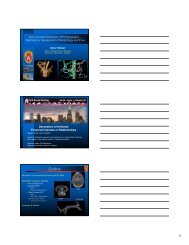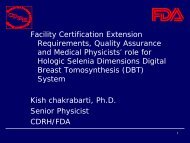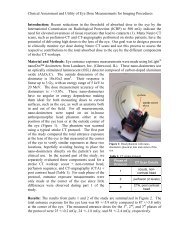Yttrium-90 Microsphere Therapy Planning and Dose Calculations ...
Yttrium-90 Microsphere Therapy Planning and Dose Calculations ...
Yttrium-90 Microsphere Therapy Planning and Dose Calculations ...
You also want an ePaper? Increase the reach of your titles
YUMPU automatically turns print PDFs into web optimized ePapers that Google loves.
<strong>Yttrium</strong>-<strong>90</strong> <strong>Microsphere</strong><br />
<strong>Therapy</strong> <strong>Planning</strong> <strong>and</strong> <strong>Dose</strong> <strong>Calculations</strong><br />
S. Cheenu Kappadath, PhD, DABR, DABSNM<br />
Department of Imaging Physics<br />
The University of Texas MD Anderson Cancer Center<br />
Houston, Texas, USA<br />
Educational Objectives<br />
To underst<strong>and</strong> the imaging sequence for <strong>Yttrium</strong>-<strong>90</strong><br />
microsphere therapy<br />
To underst<strong>and</strong> calculation of lung shunt fraction <strong>and</strong><br />
estimation of absorbed dose for lung <strong>and</strong> liver<br />
To become familiar with radiation safety <strong>and</strong><br />
regulations surrounding <strong>Yttrium</strong>-<strong>90</strong> microsphere<br />
therapy<br />
S. Cheenu Kappadath, PhD<br />
S. Cheenu Kappadath, PhD<br />
Outline<br />
AAPM 2012 Annual Meeting<br />
Overview of <strong>90</strong> Y-microsphere therapy<br />
Patient imaging prior to <strong>90</strong> Y-microsphere therapy<br />
Lung shunt fraction <strong>and</strong> lung dose calculations<br />
<strong>90</strong> Y-microsphere therapy dose calculations<br />
Patient imaging post <strong>90</strong> Y-microsphere therapy<br />
Three-compartment partition model<br />
Measurement of <strong>90</strong> Y activity <strong>and</strong> admin. activity<br />
Radiation Safety<br />
Challenges <strong>and</strong> Summary<br />
AAPM 2012 Annual Meeting<br />
2<br />
3<br />
8/2/2012<br />
1
S. Cheenu Kappadath, PhD<br />
<strong>90</strong> Y-microsphere <strong>Therapy</strong><br />
Trans-arterial delivery of radioactive <strong>90</strong> Y-labeled microspheres<br />
via a catheter directly at disease sites (targeted infusion)<br />
<strong>Microsphere</strong>s (20-30 µm) trapped in tumor capillary vessels<br />
due to their embolic size <strong>and</strong> targeted delivery<br />
© TheraSphere<br />
β emissions from trapped <strong>90</strong> Y-microspheres are capable of<br />
delivering lethal radiation doses to (proximal) neoplastic<br />
tissue while sparing (more distal) surrounding normal tissue<br />
S. Cheenu Kappadath, PhD<br />
© SIRTEX<br />
<strong>90</strong> Y-microsphere <strong>Therapy</strong><br />
<strong>90</strong> Y-microsphere therapy usually target the liver<br />
AAPM 2012 Annual Meeting<br />
<strong>90</strong> Y-microsphere therapy takes advantage of the unique<br />
circulatory system in the liver<br />
– Portal vein (normal liver) & hepatic artery (tumor)<br />
Liver directed XRT are limited in scope<br />
– Radiation tolerance of normal hepatocytes < neoplastic tissue<br />
– Max. tolerated doses 30–40 Gy (Emami et al, IJROBP 21, 1991; McGinn et al, J Clin Onc 16, 1998)<br />
With <strong>90</strong> Y-microspheres, total liver radiation doses up to 80 Gy<br />
were well tolerated with no hepatic radiation damage (Gray et al,<br />
Annals Oncology 12, 2001; Burton et al, Radiology 175, 19<strong>90</strong>)<br />
<strong>90</strong> Y-microsphere therapy is approved by the FDA for the<br />
treatment of unresectable HCC <strong>and</strong> metastatic colorectal<br />
cancer<br />
S. Cheenu Kappadath, PhD<br />
Properties of <strong>Yttrium</strong>-<strong>90</strong><br />
AAPM 2012 Annual Meeting<br />
Decay: Y-<strong>90</strong> (β - , 64.1 hr) Zr-<strong>90</strong>; a pure β - emitter<br />
– Y-<strong>90</strong> also emits β + at low yields (~32 ppm) via internal pair-production<br />
β energy: 0.937 MeV (mean) <strong>and</strong> 2.28 MeV (max)<br />
Tissue penetration depth: 2.5 mm (mean) <strong>and</strong> 11 mm (max)<br />
<strong>90</strong> Y deposits ><strong>90</strong>% of its energy in the first 5 mm of tissue<br />
<strong>90</strong> Y deposits ><strong>90</strong>% of its energy in the first 11 days<br />
Permanently implanted <strong>90</strong> Y can deliver radiation absorbed doses of<br />
∼50 Gy for 1 GBq of activity per kilogram of tissue<br />
(Berger, JNM 12, 1971)<br />
(Sarfaraz et al., Med Phys 31, 2004)<br />
AAPM 2012 Annual Meeting<br />
4<br />
5<br />
6<br />
8/2/2012<br />
2
Commercial <strong>90</strong> Y-microsphere Products<br />
SIR-Spheres®<br />
Sirtex Medical, Sydney, Australia<br />
Insoluble, biocompatible resin<br />
matrix<br />
30–35 µm glass spheres<br />
3 GBq (81 mCi) activity =<br />
30–60 x 10 6 spheres<br />
Maximum activity available:<br />
3 GBq (81 mCi)<br />
Indicated for the treatment of<br />
unresectable metastatic liver<br />
tumors from primary colorectal<br />
cancer with adjuvant<br />
chemotherapy (FUDR)<br />
S. Cheenu Kappadath, PhD<br />
TheraSphere®<br />
MDS Nordion, Ottawa, Canada<br />
Insoluble, biocompatible glass<br />
matrix<br />
20–30 µm glass spheres<br />
3 GBq (81 mCi) activity =<br />
∼1.2 x 10 6 spheres<br />
Maximum activity available:<br />
20 GBq (540 mCi)<br />
Indicated for radiation treatment<br />
or as a neoadjuvant for surgery or<br />
transplantation in patients with<br />
unresectable HCC<br />
Liver is common site of metastases from a variety of neoplasms<br />
Clinical trials on management of metastatic liver disease<br />
AAPM 2012 Annual Meeting<br />
Patient Imaging Prior to <strong>90</strong> Y <strong>Therapy</strong><br />
CT or MRI – Estimate target tumor mass<br />
IR – Selective embolize aberrant/hepatic vasculature<br />
– Int. Radiologist under fluoroscopic guidance in an angiography suite<br />
NM – 99m Tc-MAA Planar <strong>and</strong>/or SPECT imaging<br />
– MAA used as a surrogate for microspheres<br />
– Assess TA catheter placement <strong>and</strong> perfusion of targeted tumors<br />
Calculate lung shunt factor <strong>and</strong> lung dose<br />
Determine treatment dose/activity<br />
(Hall et al., J Int Onc 2, 2009)<br />
S. Cheenu Kappadath, PhD<br />
S. Cheenu Kappadath, PhD<br />
Lung <strong>Dose</strong> Consideration<br />
AAPM 2012 Annual Meeting<br />
Prevention of radiation pneumonitis<br />
– Arterio-venous shunting in neoplastic vasculature<br />
– Tc-99m MAA scans used to assess lung shunt fraction <strong>and</strong><br />
lung dose<br />
– Exclude patients with lung shunting that could result in<br />
lung radiation dose >25-30 Gy per treatment or >50 Gy<br />
cumulative<br />
(Ho et al, EJNM 24, 1997)<br />
SIR-Spheres<br />
Lung Shunting Reduction Factor<br />
20 % No Treatment<br />
Lung dose per treatment < 25 Gy<br />
TheraSphere<br />
Lung <strong>Dose</strong> Limit Gy<br />
Per Treatment 30<br />
Cumulative 50<br />
AAPM 2012 Annual Meeting<br />
7<br />
8<br />
9<br />
8/2/2012<br />
3
Lung Shunt (LS) Fraction<br />
2-4 mCi of 99mTc-MAA delivered trans-arterially in IR suite<br />
Planar scintigraphy of Thorax <strong>and</strong> Abdomen (AP <strong>and</strong> PA)<br />
Calculate Lung Shunt (LS) using the following formula<br />
=<br />
×<br />
+ Lung<br />
SIR-Spheres:<br />
geometric-mean<br />
images<br />
TheraSphere:<br />
not specified<br />
=<br />
ANTcounts × POSTcounts<br />
S. Cheenu Kappadath, PhD<br />
100 Counts Liver Counts Lung Counts Lung (%) Shunt counts GM<br />
AAPM 2012 Annual Meeting<br />
S. Cheenu Kappadath, PhD<br />
Example Lung Shunt Calculation<br />
LS (%) = Lung GM-counts / (Lung GM-counts + Liver GM-counts) x 100<br />
= 77278 / (77278 + 973962) x 100 = 7.35%<br />
– SIR-Spheres:<br />
LS < 10% (no modification)<br />
81 mCi <strong>90</strong> Y activity limit<br />
– TheraSphere:<br />
30 Gy lung dose limit<br />
222 mCi <strong>90</strong> Y activity limit<br />
AAPM 2012 Annual Meeting<br />
<strong>90</strong> Y-<strong>Therapy</strong> <strong>Planning</strong>: SIR-Spheres<br />
SIR-Spheres therapy doses are based on activity (not target<br />
radiation dose) – maximum activity of 81 mCi<br />
Empirical dosimetry models<br />
– Basic: Activity based on maximum activity & tumor fraction<br />
– BSA: Activity based on BSA & tumor involvement in liver<br />
– Lung Shunt modification: No treatment for LS > 20%<br />
Average liver dose < 80 Gy <strong>and</strong> lung dose < 25 Gy<br />
S. Cheenu Kappadath, PhD<br />
Tumor Fraction Modification<br />
Tumor fraction in<br />
liver<br />
Recommended <strong>90</strong> Yactivity<br />
> 50 % 3.0 GBq (81 mCi)<br />
25 - 50 % 2.5 GBq (67.5 mCi)<br />
< 25 % 2.0 GBq (54 mCi)<br />
Lung-Shunt Fraction Modification<br />
Lung Shunting Reduction Factor<br />
20 % No Treatment<br />
Lung dose per treatment < 25 Gy<br />
AAPM 2012 Annual Meeting<br />
10<br />
11<br />
12<br />
8/2/2012<br />
4
<strong>90</strong> Y-<strong>Therapy</strong> <strong>Planning</strong>: TheraSphere<br />
TheraSphere therapy doses are based on desired radiation<br />
dose to target mass; typically 120 to 150 Gy<br />
Target mass = whole liver or liver lobe or liver segment<br />
– Patient-specific vasculature <strong>and</strong> catheter approach (common or left or<br />
right hepatic artery) to target mass defines target mass<br />
<strong>Therapy</strong> must maintain lung dose lower than 30 Gy<br />
– Maximum activity depends on the Lung Shunt fraction<br />
S. Cheenu Kappadath, PhD<br />
Desired <strong>Dose</strong> [Gy] x Target Mass [kg]<br />
Activity Required [GBq] =<br />
50 [Gy -kg/GBq]<br />
Radiation Absorbed <strong>Dose</strong><br />
AAPM 2012 Annual Meeting<br />
<strong>Dose</strong>tissue [Gy] = Atissue [GBq] x 49.7 [Gy-kg/GBq] / Mtissue [kg]<br />
– Self dose from β emission: ><strong>90</strong>% energy deposit in
S. Cheenu Kappadath, PhD<br />
<strong>Dose</strong> <strong>Calculations</strong>: SIR-Spheres<br />
M, 53 kg, 174.5 cm BSA = 1.60 m 2<br />
Tumor<br />
involvement (TI)<br />
45% <strong>Dose</strong> modification YES<br />
Lung Shunt (LS) 7.35% <strong>Dose</strong> modification NO<br />
Basic model: 2.5 GBq (67.5 mCi)<br />
BSA model: (BSA[m 2 ] – 0.2) + TI[%]/100 = 1.85 GBq (50.1 mCi)<br />
Liver <strong>Dose</strong> [Gy] = A [GBq] x (1-LS) x 49.7 [Gy-kg/GBq] / M liver [kg]<br />
= 44.7 Gy (< 80 Gy)<br />
Lung <strong>Dose</strong> [Gy] = A [GBq] x LS x 49.7 [Gy-kg/GBq] / M lung [kg]<br />
= 6.8 Gy (
SPECT Concordance: 99m Tc-MAA & <strong>90</strong> Y<br />
Tc-99m MAA<br />
SPECT/CT<br />
24-June-2008<br />
Y-<strong>90</strong> SPECT/CT<br />
2-July-2008<br />
Fused SPECT:<br />
Tc-99m MAA<br />
<strong>and</strong> Y-<strong>90</strong><br />
S. Cheenu Kappadath, PhD<br />
AAPM 2012 Annual Meeting<br />
SAM Question 1<br />
The physical properties of <strong>Yttrium</strong>-<strong>90</strong> that<br />
makes it well suited for internal radionuclide<br />
therapy are that <strong>90</strong> Y is a pure β - emitter with a<br />
max. energy of 2.28 MeV corresponding to a:<br />
23% A. maximum tissue penetration depth of ~0.1 mm<br />
25% B. maximum tissue penetration depth of ~1 mm<br />
28% C. maximum tissue penetration depth of ~10 mm<br />
25% D. maximum tissue penetration depth of ~100 mm<br />
S. Cheenu Kappadath, PhD<br />
SAM Question 1: Answer<br />
AAPM 2012 Annual Meeting<br />
The physical properties of <strong>Yttrium</strong>-<strong>90</strong> that makes it<br />
well suited for internal radionuclide therapy are that<br />
<strong>90</strong> Y is a pure β - emitter with a maximum energy of<br />
2.28 MeV corresponding to a:<br />
A. maximum tissue penetration depth of ~0.1 mm<br />
B. maximum tissue penetration depth of ~1 mm<br />
C. maximum tissue penetration depth of ~10 mm<br />
D. maximum tissue penetration depth of ~100 mm<br />
Reference: Sarfaraz M, Kennedy AS, Lodge MA, Li XA, Wu X, Yu CX, “Radiation<br />
absorbed dose distribution in a patient treated with yttrium-<strong>90</strong> microspheres for<br />
hepatocellular carcinoma,” Medical Physics 31(9):2449-53, 2004<br />
S. Cheenu Kappadath, PhD<br />
AAPM 2012 Annual Meeting<br />
19<br />
20<br />
21<br />
8/2/2012<br />
7
SAM Question 2<br />
The most common route of <strong>90</strong> Y-microsphere<br />
administration for liver–directed therapy is:<br />
24% A. Peri-tumoral injection<br />
25% B. Implantation of <strong>90</strong>Y-brachytherapy seeds<br />
25% C. Systematic administration via intravenous injection<br />
26% D. Trans-hepatic arterial administration via catheter<br />
23%<br />
26%<br />
27%<br />
25%<br />
S. Cheenu Kappadath, PhD<br />
SAM Question 2: Answer<br />
AAPM 2012 Annual Meeting<br />
The most common route of <strong>90</strong> Y-microsphere<br />
administration for liver–directed therapy is:<br />
A. Peri-tumoral injection<br />
B. Implantation of <strong>90</strong>Y-brachytherapy seeds<br />
C. Systematic administration via intravenous injection<br />
D. Trans-hepatic arterial administration via catheter<br />
Reference: Murthy R, Nunez R, Szklaruk J, et al., “<strong>Yttrium</strong>-<strong>90</strong> microsphere therapy<br />
for hepatic malignancy: devices, indications, technical considerations, <strong>and</strong><br />
potential complications,” Radiographics 25(Supplement 1):S41-55, 2005<br />
S. Cheenu Kappadath, PhD<br />
AAPM 2012 Annual Meeting<br />
SAM Question 3<br />
The lung shunt fraction (LSF) based on 99mTc- MAA Planar images, used to estimate lung<br />
absorbed doses from <strong>90</strong>Y-microsphere therapy,<br />
is calculated as:<br />
= ×<br />
A.<br />
=<br />
×<br />
B.<br />
=<br />
×<br />
C.<br />
+<br />
+<br />
=<br />
×<br />
S. Cheenu Kappadath, PhD<br />
AAPM 2012 Annual Meeting Counts Lung Counts Lung (%) Fraction Shunt Lung 100 Counts LiverCounts Lung<br />
D.<br />
(%) Fraction Shunt Lung 100 Counts LungCounts Liver (%) Fraction Shunt Lung LiverCounts100<br />
Lung ShuntFraction(%)<br />
LungCountsLiverCounts<br />
LungCounts 100<br />
22<br />
23<br />
24<br />
8/2/2012<br />
8
SAM Question 3: Answer<br />
The lung shunt fraction (LSF) based on 99mTc-MAA Planar images, used to estimate lung absorbed doses<br />
from <strong>90</strong>Y-microsphere therapy, is calculated as: Counts LiverCounts Lung (%) Fraction Shunt 100<br />
×<br />
× 100 Counts Lung Counts Liver Counts Lung (%) Fraction Shunt Lung 100 Counts Liver Counts Lung Counts Lung (%) Fraction Shunt Lung 100 Counts LungCounts Liver (%) Fraction Shunt Lung A.<br />
= ×<br />
B.<br />
=<br />
×<br />
C.<br />
=<br />
+<br />
D.<br />
=<br />
+<br />
Reference: Gulec S, Mesoloras G, Stabin M, “Dosimetric techniques in <strong>90</strong>Ymicrosphere<br />
therapy of liver cancer: The MIRD equations for dose calculations,” J<br />
Nuclear Medicine 47:1209–11, 2006<br />
S. Cheenu Kappadath, PhD<br />
AAPM 2012 Annual Meeting<br />
SAM Question 4<br />
The typical range of planned absorbed doses to<br />
target liver tissue in <strong>90</strong> Y-microsphere internal<br />
radionuclide therapies is around:<br />
25% A. 40 – 60 cGy<br />
24% B. 80 – 120 cGy<br />
27% C. 40 – 60 Gy<br />
25% D. 80 – 120 Gy<br />
S. Cheenu Kappadath, PhD<br />
SAM Question 4: Answer<br />
AAPM 2012 Annual Meeting<br />
The typical range of planned absorbed doses to<br />
target liver tissue in <strong>90</strong> Y-microsphere internal<br />
radionuclide therapies is around:<br />
A. 40 – 60 cGy<br />
B. 80 – 120 cGy<br />
C. 40 – 60 Gy<br />
D. 80 – 120 Gy<br />
Reference: Salem R, Thurston KG, “Radioembolization with <strong>90</strong><strong>Yttrium</strong><br />
microspheres: a state-of-the-art brachytherapy treatment for primary <strong>and</strong><br />
secondary liver malignancies—Part 1: Technical <strong>and</strong> methodologic considerations,”<br />
J Vasc Interv Radiology 17:1251–1278, 2006<br />
S. Cheenu Kappadath, PhD<br />
AAPM 2012 Annual Meeting<br />
25<br />
26<br />
27<br />
8/2/2012<br />
9
Limitations of <strong>Planning</strong> Dosimetry<br />
Not intended to calculate dose to individual tumors<br />
Uses conservative assumptions to ensure safety<br />
Assumes uniform uptake of microspheres in tumor <strong>and</strong><br />
normal liver compartments<br />
Basic model:<br />
Uniform Liver & Tumor Uptake<br />
S. Cheenu Kappadath, PhD<br />
3-Compartment model:<br />
Different Liver & Tumor Uptake<br />
Realistic model: Different Liver <strong>and</strong><br />
Heterogeneous Tumor Uptake<br />
Three-compartment model: lung, liver, <strong>and</strong> tumor<br />
– Accounts for differential uptake of microspheres in liver versus tumor<br />
– All tumors, independent of their sizes or locations, grouped into the<br />
tumor compartment with a single uptake value<br />
(Ho et al., EJNM 23, 947-52, 1996)<br />
AAPM 2012 Annual Meeting<br />
Three-compartment Partition model<br />
Additional information needed<br />
– Tumor burden (M tumor) <strong>and</strong> Tumor uptake ratio (R)<br />
Estimation of fractional Tumor Involvement (TI)<br />
– M total = M liver + M tumor<br />
– M tumor = TI x M total <strong>and</strong> M liver = (1-TI) x M total<br />
Estimation of Tumor Uptake Ratio (R)<br />
Tumor MAA uptake [counts/pixel]<br />
R = Liver MAA uptake [counts/pixel]<br />
A liver [mCi] = A [mCi] x (1-LS) x M liver / (M liver + R x M tumor)<br />
A tumor [mCi] = A [mCi] x (1-LS) x R x M tumor / (M liver + R x M tumor)<br />
<strong>Dose</strong> organ [Gy] = A organ [GBq] x 49.7 [Gy-kg/GBq] / M organ [kg]<br />
S. Cheenu Kappadath, PhD<br />
S. Cheenu Kappadath, PhD<br />
(Ho et al., EJNM 23, 947-52, 1996)<br />
Example Calculation: <strong>Dose</strong><br />
LS = 7.35%<br />
Total Activity = 222 mCi<br />
Total liver = 2.76 kg<br />
TI = 45%<br />
T/N: R = 632.9/32.8 = 19.3<br />
Normal Liver<br />
– Mass = 1.52 kg<br />
– Activity = 12.3 mCi<br />
– <strong>Dose</strong> = 14.7 Gy<br />
Tumor<br />
– Mass = 1.24 kg<br />
– Activity = 193.4 mCi<br />
– <strong>Dose</strong> = 284.5 Gy<br />
Prior estimate of liver dose = 137 Gy with T/N=1<br />
AAPM 2012 Annual Meeting<br />
AAPM 2012 Annual Meeting<br />
28<br />
29<br />
30<br />
8/2/2012<br />
10
Three Compartment Model <strong>Dose</strong> Estimates<br />
3CM doses are relatively insensitive to tumor uptake threshold levels<br />
3CM yielded higher doses to tumor <strong>and</strong> lower doses to normal liver<br />
compared to BSA for both 99m Tc-MAA <strong>and</strong> <strong>90</strong> Y-bremssthralung SPECT/CT<br />
Differences in calculated dose between the 3CM <strong>and</strong> BSA models are<br />
larger for the 99m Tc-MAA scans than with the <strong>90</strong> Y scans<br />
S. Cheenu Kappadath, PhD<br />
(MacLellan &<br />
Kappadath,<br />
SNM 2012)<br />
AAPM 2012 Annual Meeting<br />
Three Compartment Model <strong>Dose</strong> Estimates<br />
Significant correlation (p
S. Cheenu Kappadath, PhD<br />
Assay of <strong>90</strong> Y Activity<br />
<strong>Dose</strong> calibration setting determined on-site with calibrated <strong>90</strong> Y activity<br />
<strong>Dose</strong> Calibrator S/N Calibration Number<br />
15722 47 x 10<br />
15724 47 x 10<br />
15725 47 x 10<br />
15728 47 x 10<br />
15729 47 x 10<br />
151034 45 x 10<br />
510034 46 x 10<br />
SIR-Spheres<br />
– Activity delivered as 81 mCi microspheres in water, 5 ml total volume<br />
– Draw microsphere solution by volume to desired activity<br />
S. Cheenu Kappadath, PhD<br />
80 5 16<br />
48 16 3<br />
34<br />
80 34<br />
46<br />
Assay of <strong>90</strong> Y Activity<br />
TheraSphere<br />
– Modification of the delivered activity is not allowed<br />
– Ordered activity would account for day/time of therapy<br />
AAPM 2012 Annual Meeting<br />
AAPM 2012 Annual Meeting<br />
Calculation of Administered Activity<br />
Percentage of activity delivered to the patient can be based on ionchamber<br />
exposure rate measurements<br />
– Before administration: dose-vial in acrylic shield<br />
– After administration: the 2L Nalgene jar with beta shield containing waste <strong>and</strong><br />
residual activity<br />
S. Cheenu Kappadath, PhD<br />
50 cm 50 cm<br />
The percentage of activity delivered to the patient<br />
⎛ Waste measurement after therapy ⎞<br />
Activity Delivered [%] = 100 × ⎜1 - ⎟<br />
⎝ <strong>Dose</strong> vial measurement before therapy ⎠<br />
Activity delivered to patient<br />
Activity Delivered [mCi] = <strong>Dose</strong> Vial Activity [mCi] × Activity Delivered [%] / 100<br />
AAPM 2012 Annual Meeting<br />
34<br />
35<br />
36<br />
8/2/2012<br />
12
<strong>90</strong> Y-microsphere <strong>Therapy</strong> Preparation<br />
S. Cheenu Kappadath, PhD<br />
S. Cheenu Kappadath, PhD<br />
Radiation Safety<br />
© TheraSphere<br />
AAPM 2012 Annual Meeting<br />
Transport<br />
– Acrylic shield will stop all beta emission <strong>and</strong> keep exposure rate low<br />
– 46 Gy (Flamen et al, PMB 53, 2008)<br />
S. Cheenu Kappadath, PhD<br />
AAPM 2012 Annual Meeting<br />
37<br />
38<br />
39<br />
8/2/2012<br />
13
Summary<br />
<strong>90</strong> Y-microsphere therapy is a promising <strong>and</strong> an increasingly<br />
popular treatment option for palliative care of patients with<br />
metastatic liver disease <strong>and</strong> unresectable HCC<br />
Decreased tumor volumes <strong>and</strong> increased time to tumor<br />
progression have been reported<br />
New objective measures of response are under investigation<br />
Improved imaging <strong>and</strong> dosimetry are beginning to yield more<br />
accurate dose estimates<br />
S. Cheenu Kappadath, PhD AAPM 2012 Annual Meeting<br />
40<br />
8/2/2012<br />
14


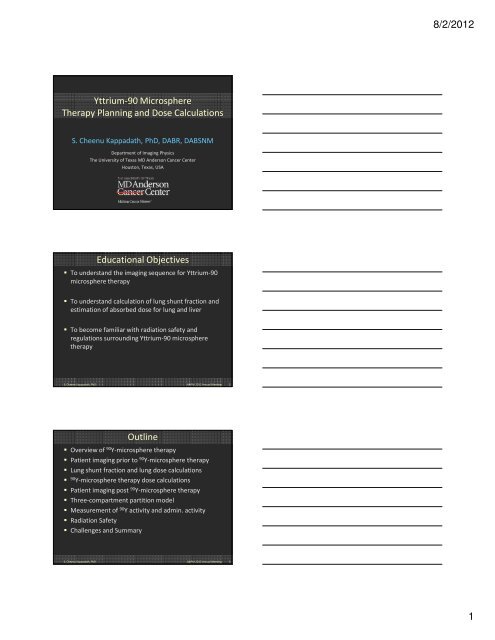



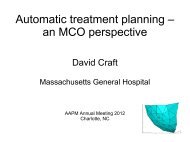

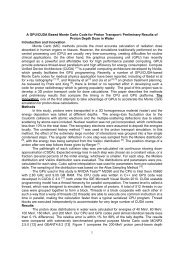
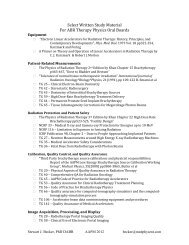
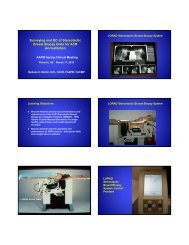
![SBRT&StereoscopicIGRT_2012 [Compatibility Mode]](https://img.yumpu.com/16889220/1/184x260/sbrtstereoscopicigrt-2012-compatibility-mode.jpg?quality=85)

